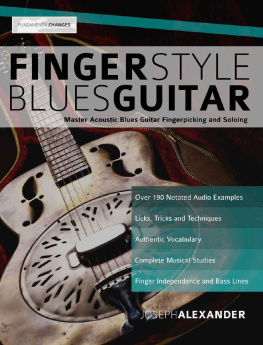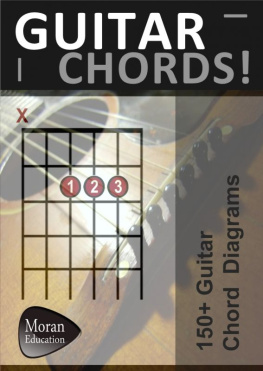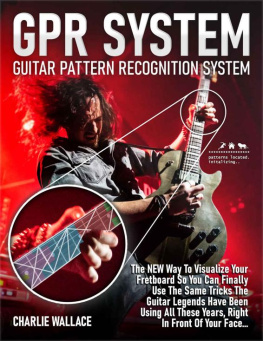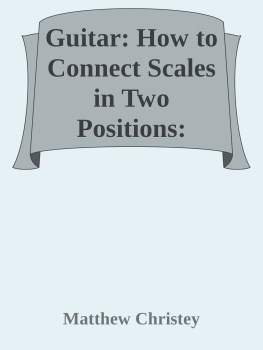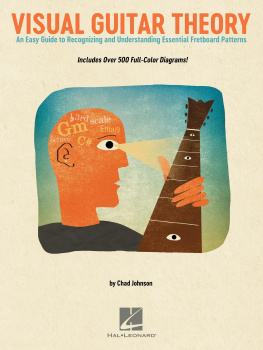The moral right of this author has been asserted.
All rights reserved. No part of this publication may be reproduced, stored in a retrieval system, or transmitted in any form or by any means, without the prior permission in writing from the publisher.
The publisher is not responsible for websites (or their content) that are not owned by the publisher.
Introduction
When we look at a guitar neck, it can be a daunting proposition to memorize the location of each note. In fact, it is quite a bit more challenging to learn the notes on the guitar than to learn them on the piano. A piano is linear ; you can only play each note at each pitch once on a piano, and the piano always ascends in pitch from left to right.
On the guitar we have six (or more!) strings. This means that we can play the same pitch in more than one location, and that the pitch of the guitar can be raised by moving both along the neck or across a string.
On the guitar, the note (E), can be played in the following locations and be at exactly the same pitch:

Each of the above notes will sound at the same pitch , but will have a different tone due to the thickness and length of the string being played. Try playing each of these notes now to hear how this sounds. Dont worry if you dont have a 24th fret on your guitar, youll get the idea!
This complication adds a bit of difficulty to memorizing the guitar neck, but once you understand how the guitar neck functions (and a few sneaky patterns), youll find that the guitar neck is quite easy to learn and that you can quickly and easily find any note you want.
One concept is to imagine each string as an individual piano keyboard. The first thing to realise is that the guitar always ascends in pitch in the same way as you move from the head of the guitar (left) to the body (right).
Each fret on the guitar is a distance of one semitone .
Two semitones are equal to one tone.
Because the distance between each fret is always a semitone, the pattern of notes on each string is always repeated. Here are the notes of E and F marked onto the diagram above so you can see how this pattern begins. We will look at this in much more detail in the next chapter.

Once you know how the patterns of notes work in music, you can quickly and easily find any note on the fretboard. There are, however, many shortcuts and patterns that will make the recall of any note instant and confident in your mind.
For over 350 Free Guitar Lessons With Videos Check Out
www.fundamental-changes.com
Note Patterns to Map the Neck
Scale s, Tones and Semitones
A scale is a series of steps between two fixed musical points. These two fixed points are always the same note but in different octaves . For example, these points could both be the note C, one being higher in pitch than the other:

While these notes are fundamentally the same, they are at a different pitch . A scale is simply a way to break up the distance in between these notes.
One way to think about this is to imagine a ladder where the first and last rungs are fixed, but you can change the spacings of any of the rungs in between. Some spaces may be smaller, some larger but however you arrange them, after climbing the ladder, you will always end up at the same fixed place.
The rungs on our ladder are the notes that we play, and the spaces between the rungs are the distances between these notes. The distances between notes are measured in tones and semitones. two semitones are equal in distance to one tone.
The most basic scale is one that contains every possible note between the root and the octave and is created by ascending the guitar neck in semitones. This scale is called the chromatic scale and contains twelve notes. The twelve notes between a low and a high C are as follows:
C C# D D# E F F# G G# A A# B C

This book isnt about scales, but the previous diagram does teach us one very important thing: There is always a full tone between every letter-named note (C, D, E, etc.) apart from E F and B C. You can see this on the white notes of a piano keyboard. Youll notice that there is a black note between every white one except for the notes E and F, and B and C.
For example, there is a tone (two frets) between the notes A and B.
There is a tone (two frets) between the notes G and A.
However, the distance between the notes E and F is only a semitone. There is no note named E# that fits between E and F.
The same is true for the notes B and C. There is no B# so the distance between the notes B and C is only one semitone.
Look again at the previous diagram and make sure you can see that there is a sharp between each letter name note apart from E F and B C.
How does this help us learn the neck?
Well, If we know the names of the open strings, we can quickly figure out where any note is on the fretboard.
The notes on the open strings from low (bass) to high (treble) are E A D G B E. You can remember this with the rhyme, Eddie Ate Dynamite, Good Bye Eddie.
Now you know that the bass string of the guitar, when played 'open' (with no fretted note), is the note E. By using our knowledge of tones and semitones, we can quickly find where all the other notes are on the E String.

As we know that there is only a one-fret distance between the notes E and F, and B and C, and that there is a two fret distance between all other notes, we can quickly map out the sixth string of the guitar.
You also know that the first (highest) string is also the note E. This means that we now know the notes on the first string too!

The next most useful string to map is the fifth (A) string.

Notice that the note on the open string (A) repeats at the twelfth fret and the pattern begins again.
Here are the patterns for the fourth (D), third (G), and second (B) strings:




